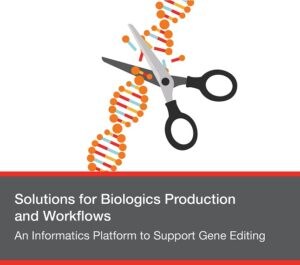An Informatics Platform to Support Gene Editing
 CRISPR rapidly took over the genome editing space, beating out Zinc Fingers and TALENs, as it grew in popularity, mostly due to its ease of use. Over the past few years, initial concerns regarding off-target effects have been alleviated thanks to more sophisticated bioinformatics tools and the ability to leverage next generation sequencing to confirm specificity. Recently, the CRISPR craze has continued to gain ground as more scientists are using this technology for everything from high throughput screening and target identification to genetic engineering in iPSCs.
CRISPR rapidly took over the genome editing space, beating out Zinc Fingers and TALENs, as it grew in popularity, mostly due to its ease of use. Over the past few years, initial concerns regarding off-target effects have been alleviated thanks to more sophisticated bioinformatics tools and the ability to leverage next generation sequencing to confirm specificity. Recently, the CRISPR craze has continued to gain ground as more scientists are using this technology for everything from high throughput screening and target identification to genetic engineering in iPSCs.
Although initial studies were performed with Cas9 nuclease variations, research into alternative enzymes has revealed optimized protein sequences from a number of different species, Cpf1, from Acidaminococcus sp. BV3L6 and Lachnospiraceae bacterium ND2006 are just two examples of what can be done. Both of these Cas9 alternatives offer scientists the ability to cleave DNA or RNA, respectively, and to manipulate the genome in locations that are not always accessible by the traditional Cas9 system.
CRISPR Technology to Improve Research Screening and to Develop Gene Therapy
Start-ups and major biopharma companies alike, are all exploring CRISPR technology, not only as a potential gene therapy option, but also as a way to create more reliable and accurate tools for screening everything from small molecules to antibodies, and more. Gene therapy initiatives are taking center stage as these prominent players position themselves as leaders in CRISPR technology. And even as the patent battle looms in the courts, scientists are jumping at the chance to advance their research through this innovative and evolving method.
Bioinformatics Tools to Assist CRISPR
The promise that CRISPR brings lies within the ability to quickly and easily manipulate target sequences. To realize these editing effects scientists decide on and create variations of guide RNA sequences, in addition, to testing out and choosing the most effective nuclease pairing. Bioinformatics tools can help this process along by proving a ranked list of guide sequence options for various PAMs (Protospacer Adjacent Motifs), show potential for off-target affects, and other characteristics, like GC content. Guide sequences can be provided packaged in expression vectors, with or without Cas9, or with fluorescent markers, alongside donor vectors engineered with your gene of interest, etc. They can also come packaged in lentivirus or as capped RNA.
The variations and the downstream applications are endless. The amount of data generated includes sequences, characteristics, confidence scores, packaging material and methods, biosafety levels and precautions, etc. Assay data pertaining to construct creation, NGS sequence confirmation, knock-out percentages, and CRISPR screening results need to be maintained, in addition to relationships between samples, like stem cells, T-cells, and immortalized cell lines.
The only way to maintain this information is through a laboratory information management system (LIMS) and a Biologics Discovery Solution made up of modular applications that allow our scientists to perform tasks from registering samples through the viral packaging, cell line development, and high throughput screening. We can provide function for any one of the processes required to work with biologics, like CRISPR/Cas9/Cpf1/etc., or we can provide functionality to get you end-to-end in your discovery pipeline.
Web Based, Platform Approach to Biologics Discovery
Our Biologics Discovery Solution, built on Thermo Fisher™ Platform for Science™ software, offers a 100% web based approach for managing all your laboratory processes, not only relating to CRISPR reagents, but for all biologics and chemistry samples. The flexible nature of our system allows you to track the data you need now and add on as your lab evolves. The applications used to manage your CRISPR work can also be used to manage all of your biologics generation, including antibodies, cell lines, and more.

Leave a Reply